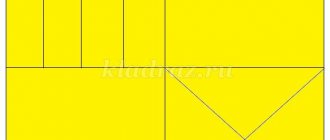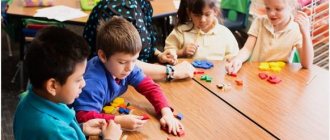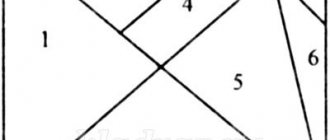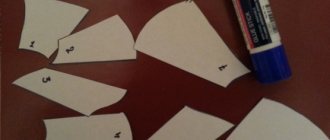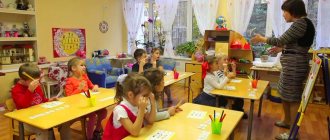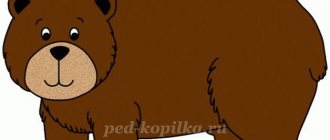Kravchenko Tatyana Aleksandrovna physical education instructor MBDOU Kindergarten No. 9 “Solnyshko” Prokopyevsk Kemerovo region
Goals and objectives: to form in children an idea of the importance of a healthy lifestyle for health, of observing personal hygiene rules, of the benefits of vitamins and healthy products, to teach them to be selective about advertising. Develop the ability to navigate in space, improve drill skills, speed, agility, attention, form posture and foot, study your body.
Equipment: didactic material - illustrations: sports, vegetables, fruits, hygiene procedures, massage balls, “pebbles” for the prevention of flat feet, model of the sun, bench, hoops.
Pupils enter the hall, sit on chairs and say hello.
Instructor: Guys, we have guests today! Say hello to your soul and heart. (The students say hello.) You know, you didn’t just say hello, you gave each other a piece of health, because you said: “Hello!” This means I wish you good health. Today we have a difficult task and I want to tell you a legend. Once upon a time there lived wise men. They were strong and healthy, smart and kind, and they really wanted all the people on earth to be the same. But one wise man said: “If they are the same as us, then they will be like us.” And they decided to hide the most important thing a person has - Health. Some suggested hiding health in the blue sea, others behind high mountains, and one sage suggested hiding health in the person himself. This is how people have lived since ancient times, trying to find their health. But not everyone can find and preserve this priceless gift. This means that health is hidden in you, and in me, and in each of you. Guys, do you feel healthy? Do you know how to become healthy? ( Children's answers.)
Instructor: I'll tell you a little secret! Our health can be compared to the sun, which has many rays, these rays live next to us, the main thing is to find them and use them correctly.
The instructor shows a model of the sun and invites the students to go in search of these rays. He gives a task for orientation in space, a verbal task for searching. For example: “Our first ray is in the upper left corner of the hall behind a long soft object.” Pupils find and attach the first ray - a picture - “Physical exercises”.
Instructor: Let's think about what benefits physical exercise brings?
Pupils: Strengthen muscles, harden the body. They give us a cheerful and good mood. Beautiful posture and eternal youth.
Instructor: Guys, let's show how we train the muscles of our body. Walking with different hand positions. Running in different directions, with stops, with tasks. Game task “Quickly change lanes.” Game "Building numbers". Relay race “Sports Experts”.
Instructor: To avoid sick people, you need to respect sports. Remember this, guys. Now let’s rest a little and do some breathing exercises.
Breathing exercises
- “Let’s warm ourselves up” Spread your arms to the sides - “inhale” through your nose, then quickly cross them in front of your chest, clap your palms on your shoulders, say “uh-h-h”, and exhale.
- “Angry hedgehog” Raise your hands up, spread your fingers (“needles”), inhale through your nose, squat lower, clasp your knees, lower your head, exhaling, say “f-r-r.”
- “Wind” Perform movements to the verses
I am a strong wind, I am flying , (Arms are lowered, legs are slightly) I am flying wherever I want: (spread apart, inhale through the nose). If I want, I’ll whistle to the left, (Turn my head to the left - exhale.) I’ll inhale, I’ll whistle to the right (Take a breath, turn my head to the right - exhale.) I’ll disperse the clouds for now, blow into the clouds. (Head straight - inhale through the nose, raise your head - calmly exhale deeply through the mouth) Instructor: Answer me the question: “Why do we do breathing exercises?”
Pupils: - So that our body is enriched with oxygen.
Instructor: That's right, guys! Without breath there is no life, Without breath the light fades. Birds and flowers breathe, He, and I, and you breathe. Instructor: So, our second ray is called “Clean Air”. Now it is located where fresh air enters our hall. The pupils find it on the windowsill and attach it to the sun. You will guess the name of the third ray when you answer my question: “Why does a person need food?” (Answers from students.)
Instructor: Our stores sell many different products and advertise them a lot. If you were asked to go to a store, would you be able to choose healthy foods? Let's play the game “Advertising Ball”. I will throw you a ball and say words, after the words you catch the ball and return the ball back with the answer “yes” or “no”.
You know ladies, gentlemen: - Snickers is the best food. (Pupils' answer) If you eat sweet Snickers, your teeth will be out of order. (Answer) In gratitude to Pepsi Cola - You will be the smartest in school. (Answer) Always gives us strength - Very strong food. (Answer) If you eat hot dogs often, you won’t be able to lift your legs soon. (Answer) The best reward in the world is a bar of chocolate. (Answer) The best reward in the world is a branch of grapes. (Answer) For colds and sore throats - Oranges help. (Answer) Well, it’s better to eat lemon - Even though it is very sour. (Answer)
Instructor: Well done! I will definitely tell your parents that you know and know how to choose healthy foods. What is the name of our next ray? "Healthy Food" He hid under a long wooden object on the right side of the hall.
Instructor: Draws attention to the illustrations - pictures and asks them to draw a conclusion: how to call what they see in one word. This is “Purity”. You said it right – this is purity. Friends, do you think cleanliness and health are connected? Why do they say “Cleanliness is the key to health!”?
Game - pantomime "Clean"
The game involves two teams. They are facing each other. The instructor names hygiene procedures, and the students must pantomime the action. The team that shows the best performance wins.
Instructor: Remember, guys, that a comb, toothbrush, towel and washcloth are personal hygiene items, and everyone should have their own. Now I want to invite you to take off your socks. Guys, tell me, why do people walk barefoot?
The students respond - they are being strengthened.
Instructor: If you harden yourself from a young age, you’ll be good for the rest of your life. There are many types of hardening, help me remember them.
- Pouring water
- Drying with a damp towel
- Gargling
- Running in a cool room
- Walking on massage mats
- Exercise in the morning and after a nap
Instructor: You will find the next ray when you collect all the pebbles.
Game task “Nimble monkeys” In the hoop there is a picture-ray covered with pebbles. Grabbing the pebbles with your toes, transfer them to another hoop. After which the fifth ray is attached - “ Hardening ”.
Instructor: There is one more ray left, and it is also very important. To be healthy, you need to know your body well, its parts, structure, and internal organs. There is a proverb: “A healthy mind in a healthy body.” Do you know your body and its parts? I suggest testing your knowledge in the game.
Game "The ball is bouncing on me"
Perform the movements according to the words of the instructor.
Take the ball in your right hand, lift it above your head and hold it in front of your chest. The ball will touch your right shoulder and will not return for long behind your back. Slowly place it on your left foot, take the ball with your left hand, hide it behind your back and touch the back of your head, press it to your ear and smile at the guests!
Instructor: Well done, guys! Let's open the last ray - “ Our body ”. Friends, look, the sun is smiling and happy for you, because you now know how to take care of your health. In conclusion, I would like to wish you “Be healthy!” And you, please, wish this to our guests.
Pupils: Be always healthy!
Tags:
- abstract
- orientation
- preparatory group
- PE
Lesson summary on the topic: “Orientation in the spatial arrangement of body parts.”
Topic: Orientation on your own body: right-left, up-down, forward-back.
Goal: developing skills of orientation in the diagram of one’s own body. Tasks: 1. Form orientation in the diagram of your own body; 2. Reinforce verbal designations for the right and left parts of the body; 3. Develop students’ coherent speech; 4. Cultivate diligence and perseverance. Progress of the lesson. I. Organizational moment. Psychological mood for the lesson. Every day - always, everywhere, in class, in games. We speak boldly, clearly and sit quietly. — Today the doll Katya came to visit us for class. Look at her carefully and tell me what kind of clothes Katya is wearing? And why? Because it's autumn now! What happens to nature in autumn? Why do we dress warmer? Who will tell Katya and me what day of the week, month, time of year it is? II. Main part. Doing exercises. 1. “My body” Goal: developing skills of orientation in the diagram of one’s own body. Content: the teacher shows the child’s body parts (torso, head, arms, legs) and names them. It turns out where a person’s head is located on the body (top), legs (bottom), arms (on the sides - right and left). Then the child is asked to show the right and left parts of the body: right eye, right ear, left cheek, right arm, left leg, etc. To provide greater clarity, you can tie a ribbon on the child's right hand. 2. “Show it correctly” Goal: developing skills of orientation in the diagram of one’s own body. Equipment: doll. Content: the teacher quickly shows parts of the body on the doll (left leg, right arm, left cheek, etc.). Children show the same part on themselves. Children can also be asked to choose a driver who shows body parts, and the rest of the participants name them. Another option is possible: the driver names one of the body parts, the children show it on themselves. 3. “What can your hands do?” The teacher explains: A person has two hands, and in order not to confuse them, each of them was given its own name - right and left. There are only two hands, but they can do a lot. What can your hands do? Goal: developing skills of orientation in the diagram of one’s own body. Content: the following questions and tasks are used to differentiate the right and left hands: Show with which hand you draw, write, eat. In which hand do you hold a pen, pencil, spoon? Show. What is this hand called? (show follows). Put the bracelet on your right (left) hand. Place your right hand behind your head first, and then your left. Throw the ball with your right hand. Move the cube with your left hand. Etc. Physical exercise. Suddenly clouds covered the sky. The prickly rain began to fall. Children stand on their toes, raise their crossed arms up. The rain will cry for a long time, It will spread slush everywhere. They jump on their toes, holding their hands on their belts. Mud and puddles on the road, Raise your legs higher. They walk in a circle, raising their legs high 4. “Find a pair” Goal: distinguish between the right and left sides of the body. Equipment: several pairs of mittens, gloves, boots, shoes, etc. Content: the child is asked to find pairs of objects for the right and left hands (legs). 5. “Show” Goal: orientation in your own body based on differentiation of the right and left parts of the body using the Head test. Contents: - show your left eye with your right hand - show your left ear with your right hand - show your left leg with your right hand - show your right eye with your left hand - show your right ear with your left hand - show your right leg with your left hand III. Final part. — what did we do in class? — evaluation of the student’s work.
